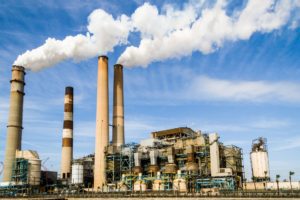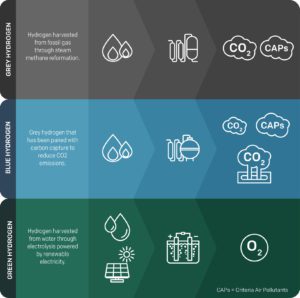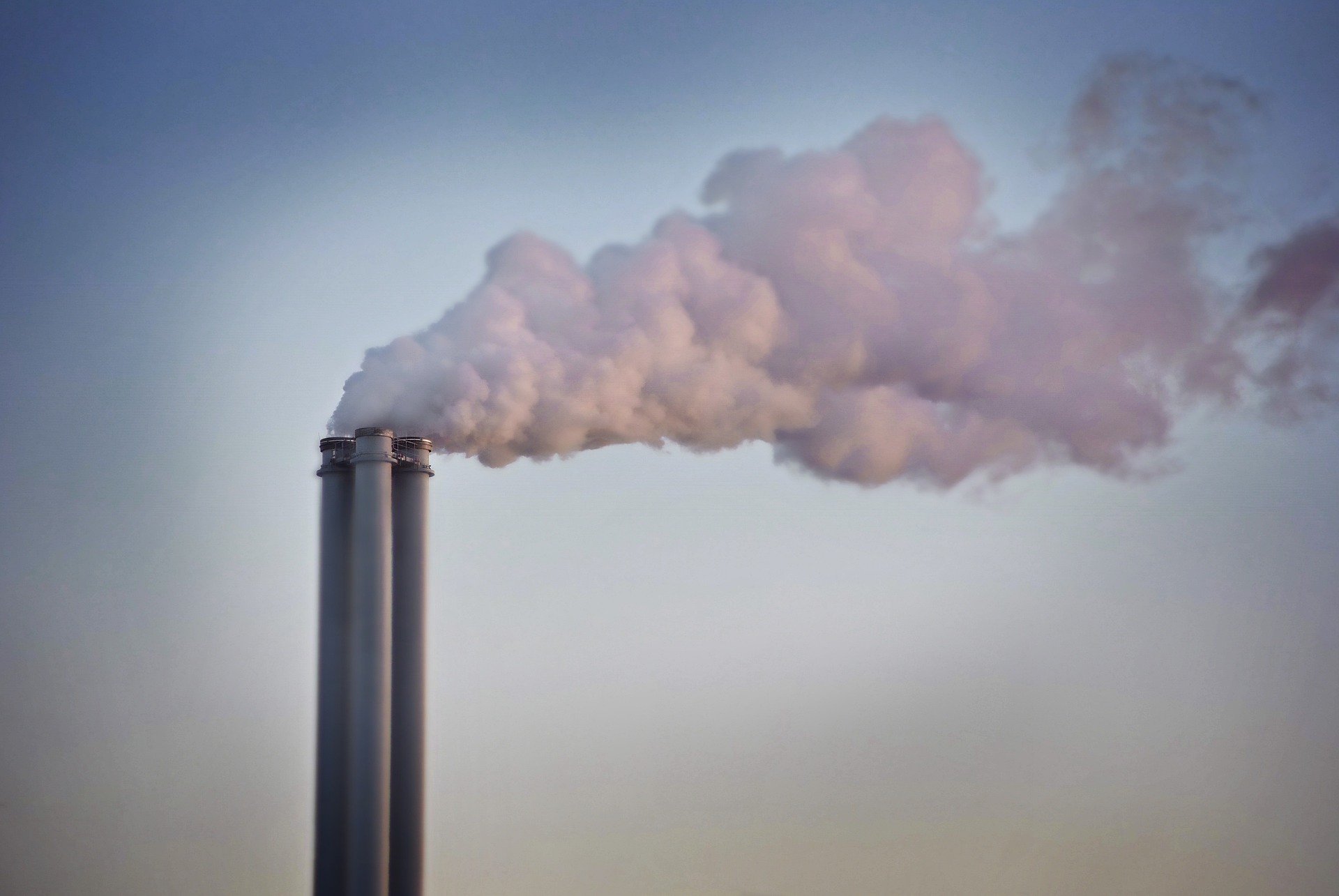
PHILADELPHIA, PA (October 13, 2020) – Today, President Biden announced that $7 billion dollars in U.S. federal grants will fund multiple groupings (“hubs”) of hydrogen projects, two located partially in Pennsylvania – one near the coast and one in the Appalachian region. Hydrogen is not a source of energy, but rather a means of storing energy derived from other sources. The coastal hub, MACH2, states that it will produce hydrogen from a mix of energy sources, including methane gas, renewables, and nuclear power. “Green” hydrogen, considered the “cleanest” form of hydrogen, is produced using renewable energy to split water molecules into hydrogen and oxygen. Green hydrogen is currently less than 1% of the global hydrogen supply. Pink hydrogen is produced using electricity from nuclear plants.
The Appalachian project, or ARCH2, will produce “blue” hydrogen with methane from fracked gas as its primary feedstock. The process of producing blue hydrogen is twofold. The hydrogen itself comes from splitting methane molecules; carbon dioxide that is released as a byproduct of this reaction is then attempted to be captured and stored. However, blue hydrogen requires environmentally harmful fracking for gas and the carbon capture and sequestration technology it relies on is largely unproven.
Joseph Otis Minott, Esq., Executive Director and Chief Counsel of Clean Air Council, issued the following statement:
“Hydrogen is not the one-size-fits-all fix to our energy needs and the climate crisis, and it could actually make greenhouse gas emissions worse. Hydrogen production is incredibly energy-intensive – even green hydrogen is a much less efficient way for industry to decarbonize compared to using renewable energy directly. Green hydrogen may be able to play a future role in specific end-uses that cannot otherwise be electrified. These massive projects are heavy on government subsidies and greenwashing and light on details. Taxpayers deserve to know more about the proposals and potential impacts.”

Pennsylvania has the fourth-highest energy related emissions in the country with coal and gas-fired power plants being the largest individual industrial climate polluters in the state. Producing electricity accounts for more than a fourth of Pennsylvania’s greenhouse gas emissions. For many years, Clean Air Council has been a major player in forcing power plants to reduce their emissions and suing to prevent the building of new fossil fuel plants. Not an easy thing to do in a state like Pennsylvania which has strong political support for coal and fracked gas.
The U.S. Environmental Protection Agency (EPA) recently proposed new national carbon emission standards for coal and gas-fired power plants. This new proposed rule would eliminate 617 million metric tons of total carbon dioxide (CO2) through 2042, equivalent to reducing the annual emissions of nearly half of all passenger vehicles in the United States. It is estimated it would prevent about 1,300 premature deaths, prevent more than 300,000 cases of asthma attacks, and prevent more than 800 hospital and emergency room visits each year.
The proposed new rule is a historic step in limiting the carbon emissions that fuel climate change as well as reducing other harmful chemicals emitted along with carbon dioxide. However, in order to achieve the greenhouse gas reductions needed to meet our climate goals and avoid the most catastrophic effects of the climate crisis, EPA must strengthen the proposed rule.
The rule’s suggested limits for gas-fired plants is based on the low emissions produced by using hydrogen or carbon capture and sequestration. There are many ways to produce hydrogen, including using natural gas which is very energy intensive. EPA needs to specify that only hydrogen produced with 100% renewable energy, known as green hydrogen, should be used. Hydrogen produced using natural gas will create more greenhouse gas pollution when we need to be reducing it.
EPA also needs to create strict rules around the transport and storage of captured CO2 to ensure these emissions do not leak into the atmosphere. Safe, secure, and permanent underground carbon storage has yet to be proven at commercial scale, so EPA must require that companies that generate carbon share the responsibility for ensuring these sequestered emissions don’t end up leaking into the atmosphere, and the long-term liability for any harms from future leakage.
While the rule rightly requires strong pollution standards at power plants that operate at a high amount of their full capacity, it should also include power plants that operate at less than full capacity, commonly referred to as “peaker plants.” These plants only operate during periods of high electricity demand, use highly polluting fuels like oil, and many are sited in Environmental Justice (EJ) areas that already struggle with air quality and environmental injustice.
The proposed rule has huge implications for Pennsylvania’s energy emissions. Comments are open until August 8th. The Council sent an action alert to encourage members to comment on the rule that provides talking points and we encourage you to use our digital platform to submit your comments and share the link with your friends. As part of the comment period, the Council also testified at an EPA public hearing about the rules.This is why we need you to submit a comment to the EPA about the proposed rule.
To learn more about EPA’s proposed rule, contact Advocacy Coordinator Susan Volz at svolz@cleanair.org

Written by Charlotte Moreno August 2022, edited by Katie Edwards, Robert Routh, Alex Bomstein
Recently, deployment of hydrogen as a fuel or energy source has become a focus for governments and industry investments both internationally (e.g., Japan, Australia, Germany) and in the US. With the global goal of net zero greenhouse gas emissions by 2050, many hypothesize that hydrogen energy will be the silver bullet to the energy transition from fossil fuels to clean energy. When burned, hydrogen does not emit greenhouse gas pollution but the different production techniques can have varying impacts as we will discuss below. The Russo-Ukrainian war has accelerated this push for clean energy to wean European and other countries off Russian oil and gas. This past June, the Biden administration publicized their intent to allocate $8 billion for the development of four regional “clean hydrogen” hubs across the country, funding which was included in the $1.2 trillion Infrastructure Investment and Jobs Act that was signed into law last November. The U.S. Department of Energy (DOE) highlights heavy-duty transportation and steel manufacturing as end-use sectors where hydrogen will assist in decarbonization. Currently companies, state and local governments, and various stakeholders are creating plans for these hubs, and DOE announced its plans to start accepting applications in September or October for funding. Given its need for industrial sector decarbonization and its substantial energy resources (particularly nuclear power and methane gas), Pennsylvania is certainly a likely region for a hydrogen hub. However, hydrogen production methods are not equal in their capacity to pollute. Knowing the differences may aid communities who face future development of hydrogen hubs in their region.
Hydrogen is the most abundant element in the universe that has potential as an energy source because of its lightweight quality and energy density. Evidence indicates that hydrogen can be used in transportation (cars, buses, trucks, airplanes, shipping), in industrial processes (steel-making, fertilizer production), and in the storage of renewable energy (to account for winter or low-wind times). The most common processes to extract hydrogen include electrolysis or steam-methane reformation which split molecules like water or methane, respectively. Hydrogen can then be pumped into a fuel cell where an electrochemical reaction occurs to create electricity. The only output is water. Developments in new processes to produce hydrogen continue to be explored.
However, we can’t talk about hydrogen without discussing the issue of how to fuel electrolysis or steam-methane reformation. Hydrogen production methods are often identified by using a color code. Methane derived from natural gas fuels the production of “gray” hydrogen through steam-methane reforming. Methane is an extremely potent climate pollutant and it leaks across all segments during its production and transportation. The process of producing hydrogen from methane also generates significant carbon dioxide pollution. Meanwhile, coal powers what’s referred to as “brown” hydrogen production, which also releases significant amounts of CO2. “Blue” hydrogen is the same as gray or brown hydrogen but adds carbon capture, utilization, and storage (CCS or CCUS), which is an effort to trap greenhouse gas emissions produced from the system and store them underground or use them to facilitate oil or gas extraction. Finally, “green” hydrogen combines renewable energy from wind or solar power with electrolysis to split hydrogen from water molecules. There are other production methods (including “pink” hydrogen produced by electrolysis via nuclear power) but the most controversial are gray, brown, and blue hydrogen because of their dependence on fossil fuels.
Not All Hydrogen is Created Equal
Clearly, not all hydrogen production methods are equal. Studies show that gray, brown, and blue hydrogen produce substantial amounts of greenhouse gas emissions. The fossil fuel industry advocates for gray, brown, and blue hydrogen because hydrogen production will continue to prop up their product and keep it marketable for years to come. Despite the benefits of burning hydrogen as a fuel source compared to fossil fuels, these production processes are anything but clean. The carbon footprint of blue hydrogen is more than 20% greater than burning methane gas or coal for heat. Additionally, 3.4% of methane, a greenhouse gas that is up to 87 times more potent than carbon dioxide at trapping heat in the atmosphere, is leaked from gas fields, storage, and transport in blue hydrogen production.
Proponents of blue hydrogen will highlight carbon capture as a way to make production cleaner. But blue hydrogen can actually be worse than gray hydrogen because more gas is required to power carbon capture, thereby producing more methane emissions. Furthermore, carbon capture projects are expensive, ineffective, and need more development. More than 80% of carbon capture projects nationwide have failed. The $1 billion project Petra Nova in Texas closed down due to mechanical problems and failure to meet carbon capture targets. In its current state of development, carbon capture cannot adequately trap target emissions from hydrogen production powered by fossil fuels. Investments in hydrogen production with low- or zero-lifecycle emissions using renewable energy are the only plausible way to combat the energy crisis effectively using hydrogen. Even so, this also involves trade-offs because we need as much renewable energy deployment as possible to generate power and clean up our electrical grid. It will be challenging to scale up the necessary amount of clean energy if we devote meaningful amounts of it to hydrogen production. Moreover, hydrogen production is incredibly energy-intensive regardless of the feedstock involved, and these energy conversions and losses mean that even green hydrogen is a much less efficient means of decarbonization when compared to, for example, direct electrification of a process using clean energy.
While there is understandable excitement for hydrogen, researchers agree that it is important to temper this enthusiasm with a realistic outlook. Hydrogen is not the one-size-fits-all fix to our energy and climate crisis and it could actually make greenhouse gas emissions worse. Hydrogen may fill a role in the energy sector, but if so, building the hydrogen infrastructure using green hydrogen or zero-emission hydrogen and targeting it to specific end-uses that otherwise cannot be electrified using clean energy will be key. Communities must keep a close eye on what the DOE and energy companies are cooking up for the hydrogen hubs which will undoubtedly shape the energy landscape for years to come.
Image credit: TANJA GEIS FOR EARTHJUSTIC, Earthjustice’s Reclaiming Hydrogen for a Renewable Future report

